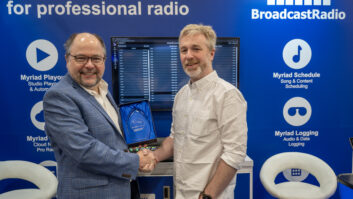My hands-on introduction to operational amplifiers was in 1969 while in the army as a junior scientist in the Atmospheric Science Laboratory at the White Sands Proving Grounds.
We had taken a tremendous amount of data on cloud formations, wind, temperature, barometric pressure and other climate conditions. All these independent and separate data items were synchronized, quantized and then converted to magnitudes of voltage levels. Finally all this information in voltage form was run simultaneously through an analog computer to establish “trends of change” and critical event points associated with that data.
Among other tasks, my job was to build the beast of this specialized computational device (I guess it qualified as a computer.)
Fig. 1: Pin-out of the LM-741. Peter Halasz/Wikimedia These machinations required us to integrate, differentiate, scale, signal process and generally “munch” the data. This data manipulation was done in operational amplifiers, or to be precise their earlier cousins, instrumentation amplifiers. These devices are really only different because they separate the functions of creating a high input impedance and amplifier gain in independent sections of laboratory precision circuitry. The op-amp integrates the two activities with the added bonus of always providing two differential inputs with opposite polarity (positive and negative).
Hundreds of tubes in the multitude of independent amp chassis meant we were never cold in our computer room even with the most frigid desert night outside.
Today’s operational amplifiers in a few ICs can replace a rack of those tube units and are far more electrically quiet, not to mention being more power efficient by several orders of magnitude.
Op-amps were an invaluable basic technology in 1969. What today’s op-amps can accomplish has expanded dramatically. At present an op-amp is defined as a general-purpose, DC-coupled, high-gain, (normally) inverting external feedback amplifier.
Fig. 2: Unity-Gain Follower (Non-Inverting) With the invention of the transistor in 1947 (see our related Milestone article “The Transistor Portable Radio”), a parallel development program of tube and discrete transistor op-amp devices competed until integrated circuit technology emerged in 1959, with the first of the IC op-amps appearing in 1961. The 741 op-amp IC, priced under $1, came to market in 1968, moving the device from novelty to the mainstream of design. See Fig. 1 for the functional diagram of the 741.
Focusing on just linear designs let’s look at some applications of the 741 as a typical op-amp.
USES
Fig. 2 shows a 741 in its most fundamental state, a unity gain configuration normally used as an isolation buffer between stages.
Fig. 3: Basic Non-Inverting Amplifier Fig. 3 is the same non-inverting configuration but set up to achieve some value of gain as set by the addition of resistors R1 and R2.
This arrangement provides gain set by R1 and R2 with the associated formula, G = 1 + (R2/R1).
In this issue’s SBE Certification Corner (page 14) we showed an op-amp in the classic inverting configuration. In comparing the formulas for inverting and non-inverting format, one can see that a non-inverting op-amp can never have gain of less then one.
Of the many valuable features of the op-amp, its very high input impedance is probably the most valuable. The input impedance of the inverting op-amp is set by the series input resistor (R1). This allows a very useful flexibility in impedance matching. In the non-inverting configuration, with direct input, the op-amp itself sets the impedance, which is usually in the range of millions of ohms.
Because gain in both the inverting and non-inverting configurations is set by the feedback, it should be intuitive that if we can “tailor” the feedback as a function of frequency, we can influence the response of the amplifier.
Fig. 4: Low-Pass Filter The circuit in Fig. 4 is a low-pass filter in a non-inverting arrangement that allows frequencies up to about 2 kHz to pass flat (the amp’s stage gain figure) with the practical values shown. At this point the response of the filter begins to roll off in correlation to the decreasing Xc of the feedback capacitors. Generally speaking the “cutoff frequency” is the point where the output voltage falls to 0.707 of the peak output.
Theoretically, inductors could replace these capacitors and with the same values of reactance we would then have a high-pass filter with an inverse frequency response curve. However inductors are not usually used as they will pass DC, which can complicate some applications, and they also have a finite amount of resistance from the wire in the inductor, which again can complicate high frequency performance.
Rearranging the capacitors so that the feedback curve is reversed creates a high-pass filter as shown in Fig. 5.
A downside of these circuits is the progressive shifting in phase of the signals going through the op-amp due to the action of the reactive feedback elements. In many cases this is critical when the system has to be phase linear. If it is not critical, such as using the low-pass circuit to remove the hiss on an incoming audio line from a sports remote, the results are amazing for the circuit simplicity.
Fig. 5: High-Pass Filter This is a good place to mention that besides determining gain, negative feedback is almost always needed to stabilize the op-amp. Many high-performance ICs that have exceptional frequency and gain numbers can and will go into self-oscillation without feedback stability. The frequency of oscillation will usually be set by either the stray reactances the op-amp output signal encounters on its way to the input on the PCB (quite often through the power supply system) or by its alpha (voltage gain) cutoff where the IC runs up to the highest frequency at which its gain is unity.
The op-amp responds well to mathematical analysis for design but they are not perfect black boxes. As in all transistor devices frequency response has finite limits and the ultra linear range for most cost-effective op-amp IC devices, such as the vanilla 741, does not extend much above the audio range. With a maximum gain factor of unity at about 1 MHz, the 741 is unsuitable for video.
COMPARATOR
At the other end of the response curve, DC signals, the op-amp has many interesting applications.
Fig. 6: Basic Non-Inverting Comparator One of these is the comparator. The op-amp is a differential amplifier, sensitive to the difference in potential between the + and – inputs. A comparator IC (e.g; LM.339) is really just a specialized op-amp that has been pre-compensated with an internal feedback loop such that when the differential between these two inputs occurs that the output changes state. Setting the gain below infinite with internal compensation makes the op-amp more stable and reduces state jittering at the decision point.
Fig. 6 is the schematic of a typical multi-section comparator op-amp that we could make using one section of a LM.339. The output will go high when the voltage on the positive input goes above the value at the negative input (and vice-versa).
Notice two special features: First, you’ll observe that the op-amp is in a single supply arrangement with just a positive voltage; second, that the amp, as mentioned, is actually in high-gain configuration so when the “tipping point” value is exceeded the output goes to essentially the rail voltage.
Fig. 7: Basic Non-Inverting Comparator Application Fig. 7 is a typical use of this arrangement creating a high ambient temperature alarm signal for your remote control system. When the DC analog of room temperature on the positive input goes above the fixed reference on the negative input (in this case an adjusted DC value corresponding to 85º F), the output of the comparator goes high giving you a voltage for the status/alarm input.
A calmer arrangement of this comparator concept with a much lower gain figure can be used as the control section of a regulated series power supply.
In Fig. 8, actually an inverting comparator, a sample of the supply output is introduced as the variable input on the negative input and the positive input has a fixed reference voltage provided by a zener diode. If the output of the supply goes above the reference, the op-amp voltage output is reduced, adjusting the supply output to the desired value. Conversely if the supply output sags, the op-amp output rises once again, bringing the supply output back to nominal.
Fig. 8: 12 Volt Voltage Regulator
CASE STUDY
Now let’s put some of these op-amp circuits together and consider a case study.
We’ll look at an LED meter replacement for the analog meter on the 400 series CBS Audimax and Volumax (see Fig. 9).
The usual casualty in the long life of the classic 400 series CBS Audimax or Volumax is the DC 1 mA “compression meter.” The meter actually reads an inverse current flow that drops when it indicates limiting. The resting point of no compression is actually the full scale indication and about 1 mA is flowing through the meter with no compression.
This upside-down arrangement to display compression was a conscious decision of the CBS engineers, who wanted no confusion between an ordinary VU meter (peaks up) and the compression operation of the CBS units … compression deflects down.
Fig. 9: CBS LED Meter – Click Image to Enlarge As mentioned, the analog meter is really showing the reduction in current flow through it. We then need to convert that representative current flow to a voltage level to drive our LED meter.
Our circuit uses three discrete 741 op-amps for this conversion and subsequent adjustment. The –12 volts needed for the 741s is taken directly from the Volumax supply and the +12 is provided by a three-pin 12 volt regulator downstream of the CBS +20 volt output.
The first 741 is a transimpedance amplifier (a current to voltage converter) where the output voltage is a function of the feedback resistor divided by the current flow. Our approximately 3 k resistor was chosen to provide a nominal –3 volt output when the current flow is 1 ma.
More on Op-AmpsFor more adventure and further exploration of op-amps, you might start with a review of the copious material on the Web including the extensive 1978 National Semiconductor compendium of circuits; see the PDF download at http://tinyurl.com/4tgy6h.
Also try the main op-amp page at Analog Devices, which has some nifty design tools: tinyurl.com/3tnkff. The second 741 is a standard inverting amplifier where we adjust the gain by varying the feedback resistance using the 50k ohm variable resistor. It increases the gain of our voltage signal but inverts the polarity to a negative range.
We need to keep the voltage swing (greatest voltage with most compression) but move it into a positive range. For this we have a third 741 which is an inverting amp with DC offset … adjusting the offset voltage pot moves the output into the positive region.
Set up your CBS unit following the instructions with a 1 mA analog meter (such as your trusty Simpson 260) in the circuit.
After wiring up your LED replacement meter, use the DC reference trimmer to set a resting place of about 1 volt output with 1 ma input from the CBS. The gain pot associated with 741 #2 is set when maximum compression is present to obtain about 10 volts out for the LED display.
The LED display uses comparators in the LED driver circuits with progressively higher trip voltages to create the LED compression display. The rest point (no compression) is fine adjusted with the pot on 741 #3. Zero current (max compression) flow precipitates 10 volts. The display steps are about 1.2 volts apart and quite effectively show the operation of the unit.
Op-amps are ubiquitous in the broadcast engineering world and for this reason a sure and certain knowledge of their uses, limitations, idiosyncrasies and design features is a valuable asset. We have only scratched the surface in this article of the immense universe of op-amps and their applications.
If readers would like to move into RF and other applications or would like some specific circuit suggestions for their station projects, let our editor know and we’ll attempt to include them in future RWEE issues. Write to [email protected].
















